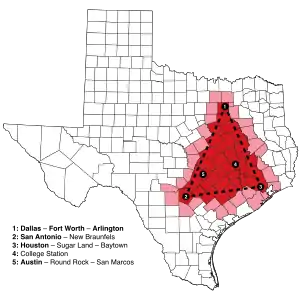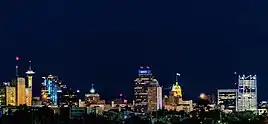Texas Triangle
Texas Triangle Megaregion | |
|---|---|
Clockwise: Houston, Austin, San Antonio, Dallas–Fort Worth | |
| Country | |
| State | |
| Population (2014) | 17,745,584 [1] |
| • Estimate (2020) | 20,852,272[2] |
The Texas Triangle (also known as Texaplex)[3][4][5] is a region of Texas which contains the state's five largest cities and is home to the majority of the state's population. The Texas Triangle is formed by the state's four main urban centers, Austin, Dallas–Fort Worth, Houston, and San Antonio, connected by Interstate 45, Interstate 10, and Interstate 35. In 2020, the population of the Texas Triangle reached nearly 21 million following rapid growth across much of Texas.[2] The Texas Triangle is one of eleven megaregions in the United States, clusters of urban areas which share economic and cultural ties.
In 2004, the Texas Triangle contained five of the 20 largest cities in the U.S., and was home to more than 70% of all Texans, with a population of 13.8 million.[6] In the next 40 years, the population of the Texas Triangle is projected to increase more than 65%,[7] or 10 million people, and comprise 78% of all Texans.
Additional metropolitan areas in the region include Bryan–College Station, Killeen–Temple–Fort Hood, and Waco. Twelve micropolitan statistical areas are within the Triangle, which includes 66 counties.[8] Beaumont, located east of Houston, has been considered part of the Texas Triangle by numerous studies dating from 2000.[9][10][11][12][13] Burleson County is the center of the Texas Triangle.
Sizable metro areas in Texas outside the Triangle are Corpus Christi, El Paso, Lubbock, Midland–Odessa, Abilene, San Angelo, Laredo, Amarillo, Tyler, Longview, Wichita Falls, and the Rio Grande Valley.
Geography

The megaregion is defined in work by America 2050 and others. Dr. Robert Lang of the Metropolitan Institute at Virginia Tech characterized Dallas–Fort Worth as one of the earliest recognized megapolitans. Although each city is distinct, Dallas and Fort Worth developed closely enough to form the urban area widely known as the Metroplex. A conference about the future of the Texas Triangle was held by Houston Tomorrow and America 2050 on September 24–25, 2009 in Houston.
The 60,000-square-mile (160,000 km2) region contains most of the state's largest cities and metropolitan areas, and in 2008 had a total of 17 million people and by 2020 had grown to nearly 21 million,[2] nearly 75% of Texas's total population.[14] The region is comparable to Florida in population and comparable to Georgia in area, but the Texas Triangle comprises less than a quarter of Texas's total land area.
According to the University of Texas at Austin Center for Sustainable Development, "the Texas Triangle has three sides measuring 271, 198, and 241 miles in ground distance."[15]
Metropolitan areas
- Austin–Round Rock–San Marcos metropolitan statistical area
- Beaumont–Port Arthur metropolitan statistical area
- Bryan–College Station metropolitan statistical area
- Dallas–Fort Worth–Arlington metropolitan statistical area
- Killeen–Temple–Fort Hood metropolitan statistical area
- Houston–The Woodlands–Sugar Land metropolitan statistical area
- San Antonio–New Braunfels metropolitan statistical area
- Sherman–Denison metropolitan area
- Waco metropolitan statistical area
Micropolitan areas
Triangle counties
The Texas Triangle contains 76 counties. They are: Anderson, Atascosa, Austin, Bandera, Bastrop, Bell, Bexar, Blanco Bosque, Brazoria, Brazos, Burleson, Burnet, Caldwell, Chambers, Collin, Colorado, Comal, Cooke, Coryell, Dallas, Denton, DeWitt, Ellis, Falls, Fannin, Fayette, Fort Bend, Freestone, Frio, Galveston, Gonzales, Grayson, Grimes, Guadalupe, Hardin, Harris, Hays, Henderson, Hill, Hood, Houston, Hunt, Jefferson, Johnson, Kaufman, Kendall, Lampasas, Lavaca, Lee, Leon, Liberty, Limestone, Madison, Matagorda, McLennan, Medina, Milam, Montgomery, Navarro, Orange, Parker, Rockwall, Robertson, San Jacinto, Somervell, Tarrant, Travis, Trinity, Walker, Waller, Washington, Wharton, Williamson, Wilson, and Wise.
Politics
The Texas Triangle can be considered one of the more politically left-wing areas in Texas due to the anchoring cities of Houston, San Antonio, Dallas, Austin, and Fort Worth. All of these cities and their respective counties of Harris, Bexar, Dallas, Travis, and Tarrant all went towards Joe Biden in 2020, with Biden flipping Tarrant County, which went for Donald Trump in 2016.
Prior to 2008, with the exception of Austin/Travis and San Antonio/Bexar (the latter a former bellwether/swing county and the former a liberal stronghold), all these cities/counties were conservative strongholds, having voted for Republicans from the 1960s through 2004.
This culminated with Barack Obama flipping Dallas, Harris, and Bexar counties to the Democratic party in 2008.
Since 1912, Travis county has been consistently a liberal stronghold at the presidential level. During this time, it only backed the Republican candidate six times, all Republican landslides except for 2000. 2000 remains the last time a Republican presidential candidate captured the county and the last time a third-party candidate affected the results. This more than likely was due to the somewhat strong showing of third-party candidate Ralph Nader, who polled in a 10.37% vote share, his best in any Texas county, likely due to some Al Gore voters voting for Nader instead.[2]
Despite being a liberal stronghold at the Presidential level, it has gone Republican more times in Senate races. For example, Kay Bailey Hutchison won the county in all but one of her Senate bids, that being 2006. Ted Cruz would continue the losing streak, losing the county in both his 2012 and 2018 bids. John Cornyn, in all his senate bids since 2002 has never won this county, and is one of two in the Triangle to never have backed him, the other being Dallas County. It has also gone Republican in gubernatorial races, most recently in 1998 when George W. Bush won a second term to the governorship.
Despite the five biggest cities being within the Triangle, there are also a great deal of rural, conservative counties. It is in these counties where Republicans poll their best.
See also
References
- "Houston leads rapid Texas Triangle Megaregion growth - Houston Tomorrow". houstontomorrow.org. Retrieved July 12, 2014.
- "The Texas Triangle Megaregion Nears 21 Million Residents | TNE". texasnewsexpress.com. Retrieved October 18, 2020.
- David Winans & MODassic Marketing. "Texaplex video". YouTube. Archived from the original on December 21, 2021.
- "Definition of "texaplex"". Texaplex.com.
- "Texaplex on NBC News". NBC D/FW.
- "The Simple Economics of the Texas Triangle - Houston Business, Jan. 2004 - FRB Dallas". Archived from the original on February 2, 2004. Retrieved July 12, 2014.
- "Reinventing The Texas Triangle - UTexas CSD - 2009" (PDF). utexas.edu. Retrieved March 25, 2014.
- "Triangle Census – Megas, Metros & Micros". Archived from the original on July 6, 2011. Retrieved December 8, 2009.
- "MegaRegions +MetroProsperity". Houston Tomorrow and America 2050. August 4, 2009. Retrieved November 8, 2014.
- Kent Butler, Sara Hammerschmidt, Frederick Steiner and Ming Zhang. "REINVENTING THE TEXAS TRIANGLE Solutions for Growing Challenges" (PDF). The University of Texas at Austin School of Architecture Center for Sustainable Development. pp. 6, 10. Archived from the original (PDF) on September 30, 2011. Retrieved November 8, 2014.
{{cite web}}: CS1 maint: multiple names: authors list (link) - Dan Seedah and Robert Harrison (September 2011). "Megaregion Freight Movements: A Case Study of the Texas Triangle" (PDF). Center for Transportation Research University of Texas at Austin (Form DOT F 1700.7 (8-72)). pp. 37–38. Retrieved November 8, 2014.
- Michael Neuman and Elise Bright (May 2008). "TEXAS URBAN TRIANGLE Framework for future growth" (PDF). Texas Transportation Institute Texas A&M University System College Station, Texas 77843-3135. pp. 4–6. Retrieved November 8, 2014.
- Ming Zhang, Frederick Steiner, Kent Butler (April 4, 2007). "Connecting the Texas Triangle: Economic Integration and Transportation Coordination" (PDF). The Healdsburg Research Seminar on MegaRegions. p. 31. Retrieved March 11, 2018.
{{cite web}}: CS1 maint: multiple names: authors list (link) - Neuman, Michael; Elise Bright (May 2008). "Texas Urban Triangle: Framework for Future Growth". SWUTC/08/167166-1. Texas A&M University System. Archived from the original on July 6, 2009. Retrieved June 21, 2009.
- Kent Butler; Sara Hammerschmidt; Frederick Steiner; Ming Zhang (2009). "Defining The Region" (PDF). Reinventing the Texas Triangle. Center for Sustainable Development, School of Architecture, The University of Texas at Austin. p. 5. Archived from the original (PDF) on September 30, 2011. Retrieved July 25, 2011.
External links
- America2050.org
- Research on the Texas Triangle, University of Texas at Austin
- TexasTriangle.biz
- TexasTriangle.org
- Texaplex.com


.jpg.webp)
